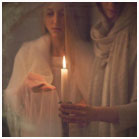|
SAMHAIN
(© Caillean)
Samhain, meaning “end of
summer”, is the ancient celtic festival which
marked the beginning of winter and of the new
year. It was considered a day out of time and
space because it marked at the same time the
beginning and the end of a cycle. From this
moment, the days become shorter, the nights are
misty and darker, the energies of nature retire
in the underworld until the winter solstice,
around December 21st, when the sun will be
reborn. It is likely that this important
festival took place in the days of the full moon
of the actual months of October/November, which
means the period of the last harvest, when
leaves are falling ,leaving trees bare and
exposed to the rustling winds, and apples and
pumpkins are everywhere. These are ancient
symbols of the Mother of Harvest, the ancient
goddess of the land who gave abundant fruits to
her sons and daughters.
Samhain is the time of the
dead and the dying, of the Ancestors, and the
theme of celebrating death and rebirth and the
mysteries of life are widespread in ancient
cultures. From pre-historic times, this is a
very special and sacred period , celebrated also
through the construction of megalithic tombs and
monuments such as stonhenge, avebury, new
grange.
In Avalon, Samhain in also
called Calan Gaef. We celebrate the mother
goddess Rhiannon, who lead us through the
station of the inner Descent, to the core of our
being and the mysteries within.
We also celebrate the crone
goddess Ceredwen, the keeper of the sacred
cauldron of inspiration, of death-rebirth and
regeneration. We remember our dead, and feel the
thread of life which link us to them and to our
descendants. During these days, the Veil
separating our world from the Otherworld,
becomes thinner and we can glimpse through it,
seeing the past and the future. It is a time of
deep reflection and preparation for the cold and
short days of winter, leading us to a new cycle.
It is a time of dreaming and planning, we plant
the seeds for the new season and nurture them
with hopes and dreams. We reflect upon the past
days, and learn our lessons.
Symbols of this period are
especially apples. Avalon in the land of apples,
a place of immortality and communion with the
goddess. Apples keep the secrets of nature and
time and we use them to represent the triple
goddess: virgin, mother and crone.
Nowadays in the US and
Europe is very popular the celebration of
Halloween, which has replaced the old
commemoration day of the dead. The ghosts and
monsters populating this day are the ancient
symbols of the communion with the beings of the
Otherworld, which have been misinterpreted in
Christian times. Pumpkins are very popular also.
They represent a symbol of the crone goddess, of
her belly, from which we come and to which we
shall return to be reborn. The rite of carving
pumpkins can also be related to ancient rituals
in which the head of dead warriors were treated
and buried to preserve them from corruption. In
fact, it was believed that the spirit of the
person was kept in his/her head.
Another important element
of this celebration is fire. The Celts
considered only three elements: earth, air and
water: fire was the representation of energy and
transformation. Bonfires were lit in the
countryside all over the world to celebrate the
harvest time, keep away evil spirits and
celebrate the deities of abundance and nature.
Fire is a transformative force: it burns
everything we don’t want to keep anymore and
leaves place for a new growth. Like trees, in
these days we keep our fruits and let our leaves
fall; we stand bare, waiting for rebirth,
celebrating the Goddess of Transformation.
|
![]()


